ZTE V9VITA LTE/WCDMA/GSM(GPRS) Multi-Mode Digital Mobile Phone User Manual
ZTE Corporation LTE/WCDMA/GSM(GPRS) Multi-Mode Digital Mobile Phone Users Manual
ZTE >
Users Manual
ZTE BLADE V9 VITA
User Manual

2
LEGAL INFORMATION
Thank you for choosing this ZTE mobile device. In order to
keep your device in its best condition, please read this
manual and keep it for future reference.
Copyright
Copyright © 2018 ZTE CORPORATION
All rights reserved.
No part of this publication may be quoted, reproduced,
translated or used in any form or by any means, electronic or
mechanical, including photocopying and microfilm, without
the prior written permission of ZTE Corporation.
Notice
ZTE Corporation reserves the right to make modifications on
print errors or update specifications in this guide without prior
notice. This manual has been designed with the utmost care
to ensure the accuracy of its content. However, all
statements, information and recommendations contained
therein do not constitute a warranty of any kind, either
expressed or implied. We offer self-service for our
smartphone users. Please visit the ZTE official website (at
www.ztedevice.com) for more information on self-service and
supported product models. Information on the website takes
precedence.
Disclaimer
ZTE Corporation expressly disclaims any liability for faults

3
and damages caused by unauthorized modifications of the
software.
Images and screenshots used in this manual may differ from
the actual product. Content in this manual may differ from the
actual product or software.
Trademarks
ZTE and the ZTE logos are trademarks of ZTE Corporation.
Android is a trademark of Google LLC; Oreo is a trademark
of Mondelez International, Inc. group.
The Bluetooth®word mark and logos are registered
trademarks owned by the Bluetooth SIG, Inc.and any use of
such marks by ZTE Corporation is under license.
microSDXC Logo is a trademark of SD-3C, LLC.
Qualcomm® Snapdragon™ processors are products of
Qualcomm Technologies, Inc.
Qualcomm and Snapdragon are trademarks of Qualcomm
Incorporated, registered in the United States and other
countries. Used with permission.
Other trademarks and trade names are those of their
respective owners.
Version No.: R1.0
Edition Time: January 19, 2018
4
Contents
For Your Safety ........................................................ 7
General Safety .................................................................. 7
FCC RF Exposure Information (SAR) .............................. 8
FCC Regulations ............................................................. 10
Distraction ........................................................................ 12
Product Handling ............................................................. 13
Electrical Safety ............................................................... 16
Interference ..................................................................... 17
Explosive Environments .................................................. 19
Getting Started ....................................................... 20
Overview .......................................................................... 20
Keys Explained ................................................................ 22
Starting up ....................................................................... 23
Powering On/Off .............................................................. 25
Getting Around Your Phone ............................................ 27
Phone Calls ............................................................ 31
Making Calls .................................................................... 31
Receiving Calls ................................................................ 33
Call settings ..................................................................... 35
Contacts ................................................................. 37
Creating a Contact .......................................................... 37
Searching for a Contact .................................................. 37
Messages ................................................................ 38
5
Opening the Messages Screen ...................................... 38
Sending a Message ........................................................ 38
Changing Message Settings .......................................... 39
Using Your Fingerprint .......................................... 40
Using Face Detection to Unlock screen .............. 42
Connecting to Networks and Devices .................. 43
Setting Access Point Names .......................................... 43
Turning Wi-Fi On and Connect to a Wi-Fi Network ....... 44
Bluetooth ......................................................................... 45
Tethering & portable hotspot .......................................... 45
Chrome ................................................................... 47
Opening the Browser ...................................................... 47
Using Multiple Browser Tabs ......................................... 48
Downloading Files .......................................................... 48
Changing Browser Settings ............................................ 48
Using Multimedia Apps ......................................... 49
Taking Pictures with Your Camera ................................ 49
Recording Videos with Your Camcorder ....................... 49
Listening to Your FM Radio ............................................ 50
Playing Your Music ......................................................... 51
Opening Your Gallery ..................................................... 51
Making Voice Memos ..................................................... 51
Using Your Google Applications .......................... 52
Gmail ............................................................................... 52
6
Google Play™ Store ....................................................... 53
Other Applications ................................................. 53
Clock ................................................................................ 53
File Manager.................................................................... 53
Downloads ....................................................................... 54
Settings ................................................................... 54
Network & Internet .......................................................... 54
Connected Devices ......................................................... 56
Apps & Notifications ........................................................ 57
Featured .......................................................................... 57
Power Manager ............................................................... 58
Display ............................................................................. 58
Sound .............................................................................. 58
Storage ............................................................................ 58
Security & Location ......................................................... 59
Accounts .......................................................................... 59
Accessibility ..................................................................... 59
Google ............................................................................. 59
System ............................................................................. 60
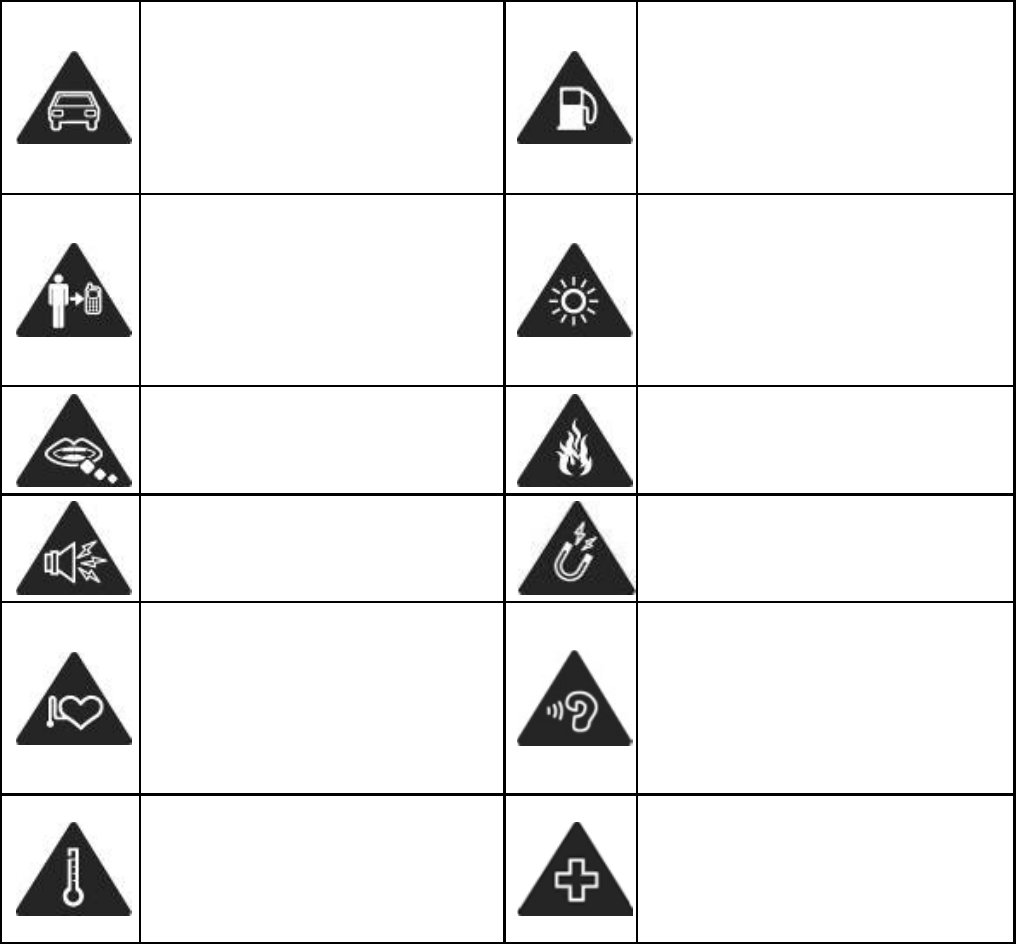
7
For Your Safety
General Safety
Don’t make or receive
handheld calls while
driving. And never text
while driving.
Don’t use at petrol
stations.
Keep your phone at
least 10 mm away from
your body while making
calls.
Your phone may produce
a bright or flashing light.
Small parts may cause
a choking.
Don’t dispose of your
phone in fire.
Your phone can
produce a loud sound.
Avoid contacting with
anything magnetic.
Keep away from
pacemakers and other
electronic medical
devices.
To prevent possible
hearing damage, do not
listen at high volume
levels for long periods.
Avoid extreme
temperatures.
Switch off when asked to
in hospitals and medical
facilities.
Don’t use at petrol
Your phone may produce
a bright or flashing light.
Don’t dispose of your
Avoid contacting with
anything magnetic.
To prevent possible
hearing damage, do not
listen at high volume
levels for long periods.
Switch off when asked to
in hospitals and medical
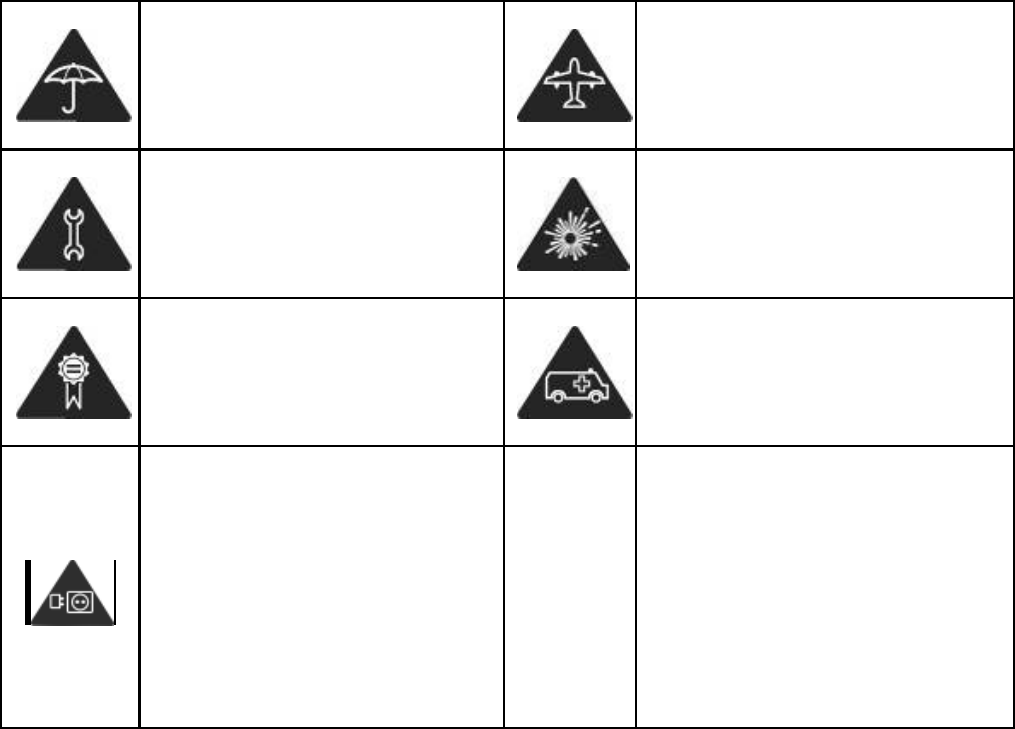
8
Avoid contacting with
liquids. Keep your
phone dry.
Switch off when told to in
aircrafts and airports.
Don’t take your phone
apart.
Switch off when near
explosive materials or
liquids.
Only use approved
accessories.
Don’t rely on your phone
for emergency
communications.
For pluggable
equipment, the
socket-outlet shall be
installed near the
equipment and shall be
easily accessible.
FCC RF Exposure Information (SAR)
This phone is designed and manufactured notto exceed the
emission limits for exposure toradio frequency (RF) energy
set by the FederalCommunications Commission of the
UnitedStates.
During SAR testing, this device was set totransmit at its
highest certified power levelin all tested frequency bands,
and placed inpositions that simulate RF exposure in
9
usageagainst the head with no separation, and nearthe body
with the separation of 10 mm. Althoughthe SAR is
determined at the highest certifiedpower level, the actual
SAR level of the devicewhile operating can be well below the
maximumvalue. This is because the phone is designedto
operate at multiple power levels so as to useonly the power
required to reach the network. Ingeneral, the closer you are
to a wireless basestation antenna, the lower the power
output.
The exposure standard for wireless devicesemploying a unit
of measurement is known asthe Specific Absorption Rate, or
SAR.The SAR limit set by the FCC is 1.6W/kg.
This device is complied with SAR for generalpopulation
/uncontrolled exposure limits inANSI/IEEE C95.1-1992 and
had been tested inaccordance with the measurement
methods andprocedures specified in IEEE1528.
The FCC has granted an EquipmentAuthorization for this
model phone with allreported SAR levels evaluated as in
compliancewith the FCC RF exposure guidelines.
SARinformation on this model phone is on file withthe FCC
and can be found under the DisplayGrant section
ofwww.fcc.gov/oet/ea/fccid aftersearching on FCC ID:
SRQ-V9VITA. The FCC ID also can be found on the device

10
when you touchSetting Icon: >System >About phone.
For this device, the highest reported SAR valuefor usage
against the head is 0.640 W/kg, forusage near the body is
0.855W/kg.
While there may be differences between theSAR levels of
various phones and at variouspositions, they all meet the
governmentrequirements.
SAR compliance for body-worn operation isbased on a
separation distance of 10 mmbetween the unit and the
human body. Carrythis device at least 10 mm away from
yourbody to ensure RF exposure level compliantor lower to
the reported level. To support bodywornoperation, choose
the belt clips or holsters,which do not contain
metalliccomponents, tomaintain a separation of 10 mm
between thisdevice and your body.
RF exposure compliance with any body-wornaccessory,
which contains metal, was not testedand certified, and use
such body-worn accessoryshould be avoided.
FCC Regulations
This mobile phone complies with part 15 of the FCC Rules.
Operation is subject to the following two conditions: (1) This
11
device may not cause harmful interference, and (2) this
device must accept any interference received, including
interference that may cause undesired operation.
This mobile phone has been tested and found to comply with
the limits for a Class B digital device, pursuant to Part 15 of
the FCC Rules.
These limits are designed to provide reasonable protection
against harmful interference in a residential installation. This
equipment generates, uses and can radiate radio frequency
energy and, if not installed and used in accordance with the
instructions, may cause harmful interference to radio
communications.
However, there is no guarantee that interference will not
occur in a particular installation. If this equipment does cause
harmful interference to radio or television reception, which
can be determined by turning the equipment off and on, the
user is encouraged to try to correct the interference by one or
more of the following measures:
• Reorient or relocate the receiving antenna.
• Increase the separation between the equipment and
receiver.
12
• Connect the equipment into an outlet on a circuit different
from that to which the receiver is connected.
• Consult the dealer or an experienced radio/TV technician
for help.
CAUTION: Changes or modifications not expressly approved
by the party responsible for compliance could void the user’s
authority to operate the equipment.
The antenna(s) used for this transmitter must not be
co-located or operating in conjunction with any other antenna
or transmitter.
Distraction
Driving
Full attention must be given to driving at all times in order to
reduce the risk of an accident. Using a phone while driving
(even with a hands free kit) can cause distraction and lead to
an accident. You must comply with local laws and
regulations restricting the use of wireless devices while
driving.
Operating Machinery
Full attention must be given to operating the machinery in
order to reduce the risk of an accident.
13
Product Handling
General Statement on Handling and Use
You alone are responsible for how you use your phone and
any consequences of its use.
You must always switch off your phone wherever the use of a
phone is prohibited. Use of your phone is subject to safety
measures designed to protect users and their environment.
Always treat your phone and its accessories with care
and keep it in a clean and dust-free place.
Do not expose your phone or its accessories to open
flames or lit tobacco products.
Do not expose your phone or its accessories to liquid,
moisture or high humidity.
Do not drop, throw or try to bend your phone or its
accessories.
Do not use harsh chemicals, cleaning solvents, or
aerosols to clean the device or its accessories.
Do not paint your phone or its accessories.
Do not attempt to disassemble your phone or its
accessories, only authorized personnel can do so.
Do not expose your phone or its accessories to extreme
temperatures, minimum - [10] and maximum + [55]
degrees Celsius.
14
The phone's normal operating temperature is 0 ~ ℃
45 .In order to ensure the normal phone functions, do ℃
not use this phone outside the temperature range.
Please check local regulations for disposal of electronic
products.
Do not carry your phone in your back pocket as it could
break when you sit down.
Use careful with the earphone maybe possible excessive
sound pressure from earphones and headphones can
cause hearing loss
.
Small Children
Do not leave your phone and its accessories within the reach
of small children or allow them to play with it.
They could hurt themselves or others, or could accidentally
damage the phone.
Your phone contains small parts with sharp edges that may
cause an injury or may become detached and create a
choking hazard.
Demagnetization
To avoid the risk of demagnetization, do not allow electronic
devices or magnetic media close to your phone for a long
time.
15
Electrostatic Discharge (ESD)
Do not touch the nano-SIM card’s metal connectors.
Antenna
Do not touch the antenna unnecessarily.
Normal Use Position
When placing or receiving a phone call, hold your phone to
your ear, with the bottom towards your mouth.
Air Bags
Do not place a phone in the area over an air bag or in the air
bag deployment area.
Store the phone safely before driving your vehicle.
Seizures/ Blackouts
The phone can produce a bright or flashing light.
Repetitive Motion Injuries
To minimize the risk of RSI when texting or playing games
with your phone:
Do not grip the phone too tightly.
Press the buttons lightly.
Use the special features which are designed to minimize
the times of pressing buttons, such as Message
16
Templates and Predictive Text.
Take lots of breaks to stretch and relax.
Emergency Calls
This phone, like any wireless phone, operates using radio
signals, which cannot guarantee connection in all conditions.
Therefore, you must never rely solely on any wireless phone
for emergency communications.
Loud Noise
This phone is capable of producing loud noises, which may
damage your hearing. Turn down the volume before using
headphones, Bluetooth stereo headsets or other audio
devices.
Phone Heating
Your phone may become warm during charging and during
normal use.
Electrical Safety
Accessories
Use only approved accessories.
Do not connect with incompatible products or accessories.
Take care not to touch or allow metal objects, such as coins
or key rings, to contact or short-circuit in the battery
17
terminals.
Connection to a Car
Seek professional advice when connecting a phone interface
to the vehicle electrical system.
Faulty and Damaged Products
Do not attempt to disassemble the phone or its accessory.
Only qualified personnel can service or repair the phone or
its accessory.
If your phone or its accessory has been submerged in water,
punctured, or subjected to a severe fall, do not use it until
you have taken it to be checked at an authorized service
centre.
Interference
General Statement on Interface
Care must be taken when using the phone in close
proximity to personal medical devices, such as pacemakers
and hearing aids.
Pacemakers
Pacemaker manufacturers recommend that a minimum
separation of 15 cm be maintained between a mobile phone
and a pacemaker to avoid potential interference with
thepacemaker. To achieve this, use the phone on the
18
opposite ear to your pacemaker and do not carry it in a
breast pocket.
Hearing Aids
People with hearing aids or other cochlear implants may
experience interfering noises when using wireless devices or
when one is nearby.
The level of interference will depend on the type of hearing
device and the distance from the interference source,
increasing the separation between them may reduce the
interference. You may also consult your hearing aid
manufacturer to discuss alternatives.
Medical Devices
Please consult your doctor and the device manufacturer
to determine if operation of your phone may interfere with
the operation of your medical device.
Hospitals
Switch off your wireless device when requested to do so in
hospitals, clinics or health care facilities. These requests are
designed to prevent possible interference with sensitive
medical equipment.
Aircraft
Switch off your wireless device whenever you are instructed
to do so by airport or airline staff.
19
Consult the airline staff about the use of wireless devices on
board the aircraft. If your device offers a ‘flight mode’, this
must be enabled prior to boarding an aircraft.
Interference in Cars
Please note that because of possible interference to
electronic equipment, some vehiclemanufacturers forbid
the use of mobile phones in their vehicles unless a
hands-free kit with an external antenna is included in the
installation.
Explosive Environments
Petrol Stations and Explosive Atmospheres
In locations with potentially explosive atmospheres, obey all
posted signs to turn off wireless devices such as your phone
or other radio equipment.
Areas with potentially explosive atmospheres include fuelling
areas, below decks on boats, fuel or chemical transfer or
storage facilities, areas where the air contains chemicals or
particles, such as grain, dust, or metal powders.
Blasting Caps and Areas
Power off your mobile phone or wireless device when in a
blasting area or in areas posted power off “two-way radios”
or “electronic devices” to avoid interfering with blasting
operations.
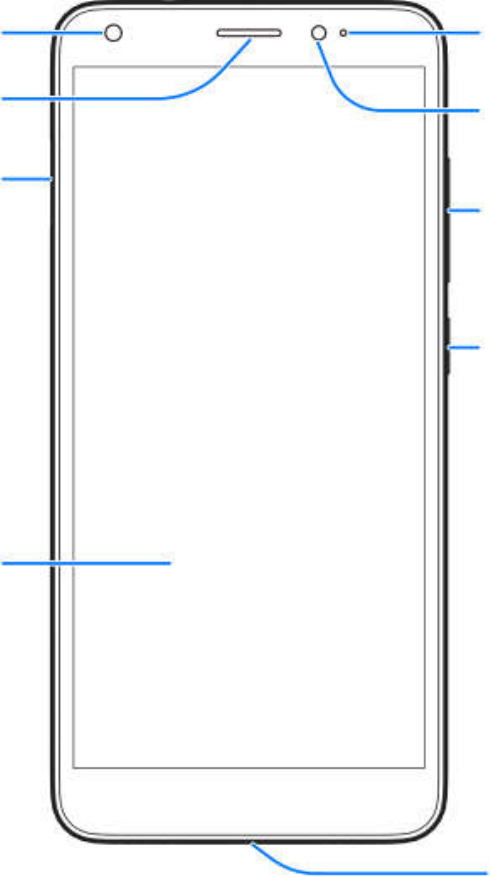
20
Getting Started
Overview
Front camera
Touch screen
Earpiece
Proximity &
light sensor
Volume key
Indicator light
Power key
nano-
SIM/
microSDXC
card tray
Charging/
micro-
USB jack
Proximity &
Volume key
Indicator light
USB jack
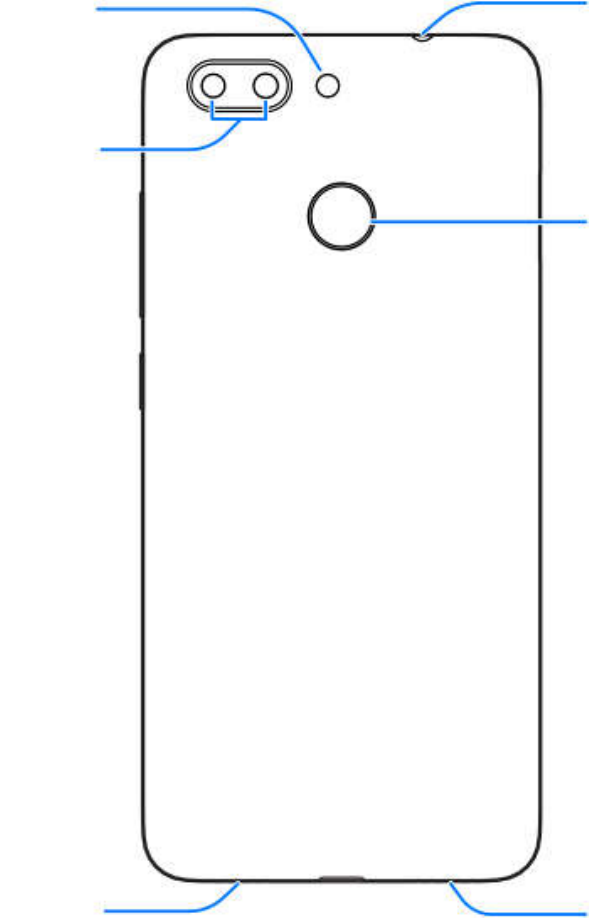
21
Flash
Headset jack
Dual-
lens
camera
Speaker
Fingerprint
sensor
Microphone
Headset jack
Fingerprint
Microphone
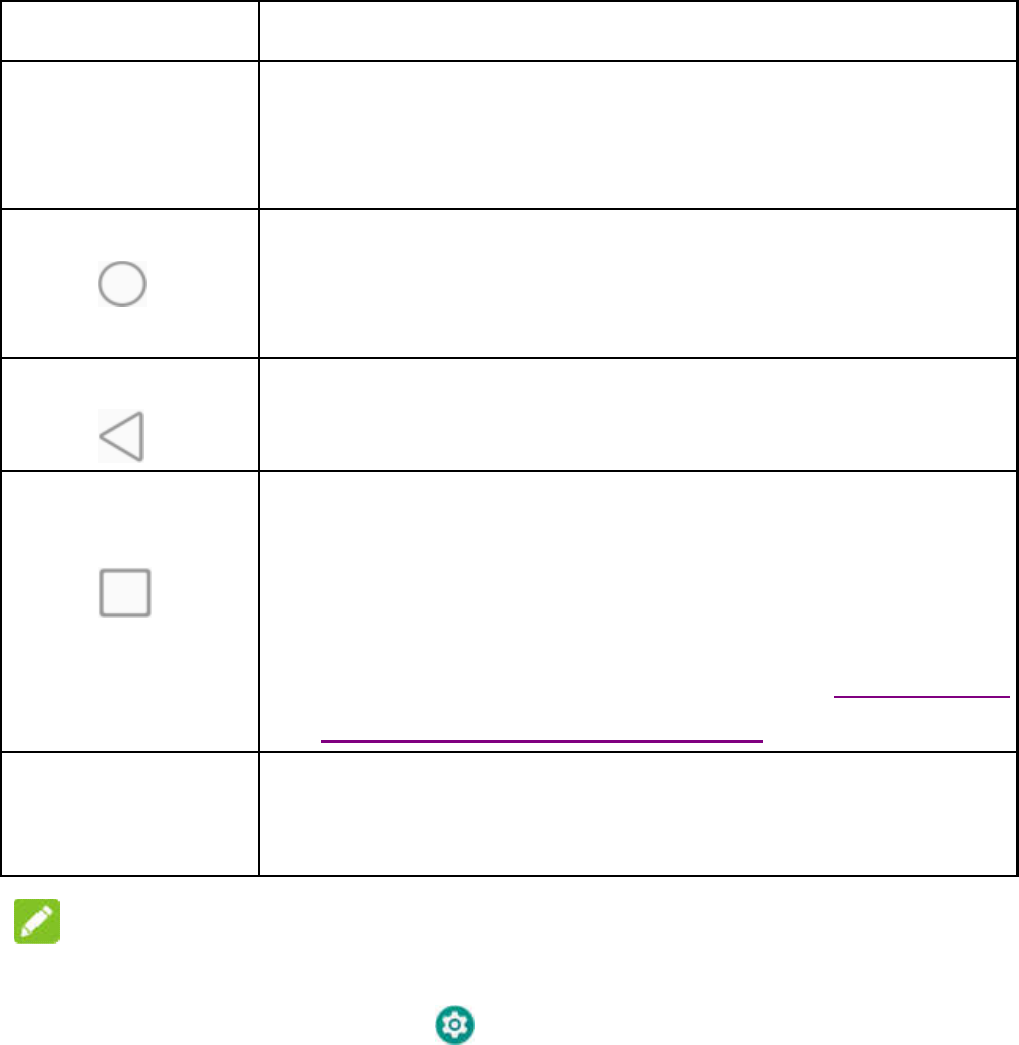
22
Keys Explained
Key Function
Power key
Press
and hold to turn on or off airplane
mode, restart, or power off.
Press to turn off or on the screen display.
Home key
Touch to return to the home screen from
any application or screen.
Touch and hold to use Google
Assistant
Back key
Touch to go to the previous screen.
Recent apps
key
Touch to see recently used apps.
Double-
tap to switch to the most recent
application.
Press and hold while using an app to
activate split-screen mode (see
Using Two
Apps in Split-Screen Mode)
Volume key Press or hold either end to
turn the volume
up or down.
NOTE:
The positions of the Recent apps key and the Back
key are
interchangeable through > Featured
> Navigation keys
and hold to turn on or off airplane
Press to turn off or on the screen display.
Touch to return to the home screen from
Assistant
.
tap to switch to the most recent
Press and hold while using an app to
Using Two
turn the volume
key are
> Navigation keys
.
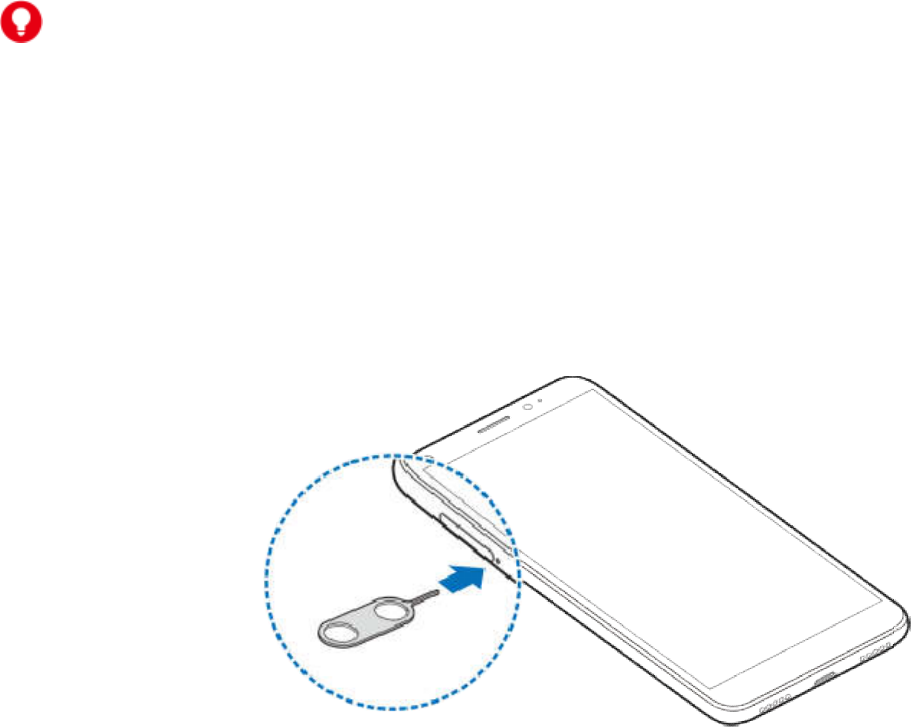
23
Starting up
Install the nano-SIM Card and the microSDXC™
Card
The microSDXC card (optional, not included) can be installed
or removed while the phone is turned on. You need to
unmount the microSDXC card before removing it.
WARNING!
To avoid damage to the phone, do not use any other kind of
SIM cards, or any non-standard nano-
SIM card cut from a
SIM card. You can get a standard nano-
SIM card from your
service provider.
1.
Insert the tip of the tray eject tool into the hole next to the
card tray.
2. Pull out the card tray and place the nano-SIM ca
rd and
the microSDXC card on the tray, as shown. Carefully
slide the tray back into place.
Card
The microSDXC card (optional, not included) can be installed
or removed while the phone is turned on. You need to
To avoid damage to the phone, do not use any other kind of
SIM card cut from a
SIM card from your
Insert the tip of the tray eject tool into the hole next to the
rd and
the microSDXC card on the tray, as shown. Carefully
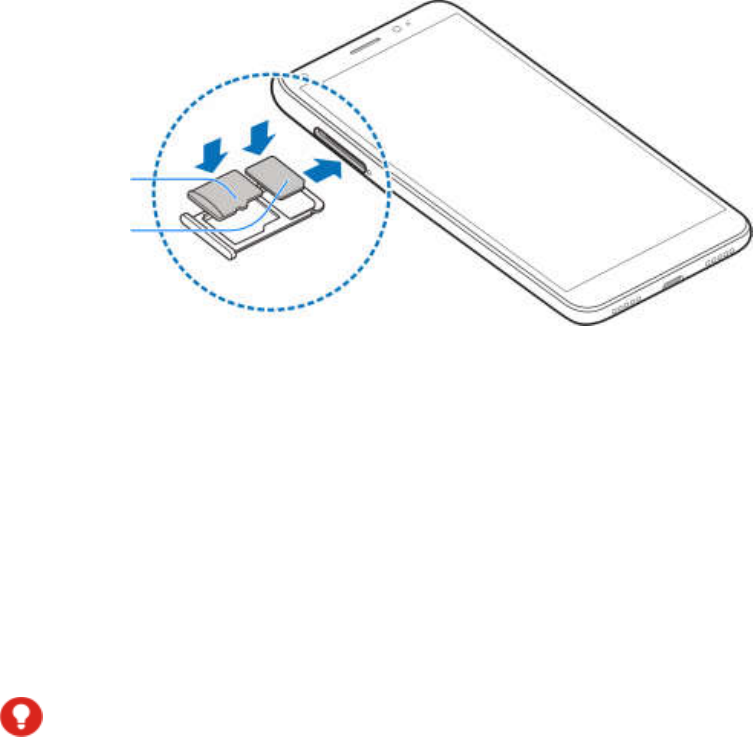
24
Charge the Battery
Your phone’s battery should have enough power for the
phone to turn on, find a signal, and make a few calls. You
should fully charge the battery as soon as possible.
If the battery is low, there will be a pop-up message on the
screen. As you charge your phone, the lock screen will show
you the exact battery level on the status bar.
WARNING!
Use only ZTE-approved chargers and cables. The use of
unapproved accessories could damage your phone or cause
the battery to explode.
1. Connect the adapter to the charging jack. Ensure that the
adapter is inserted with the correct orientation. Do not
force the connector into the charging jack.
microSDXC
card
nano-
SIM
card
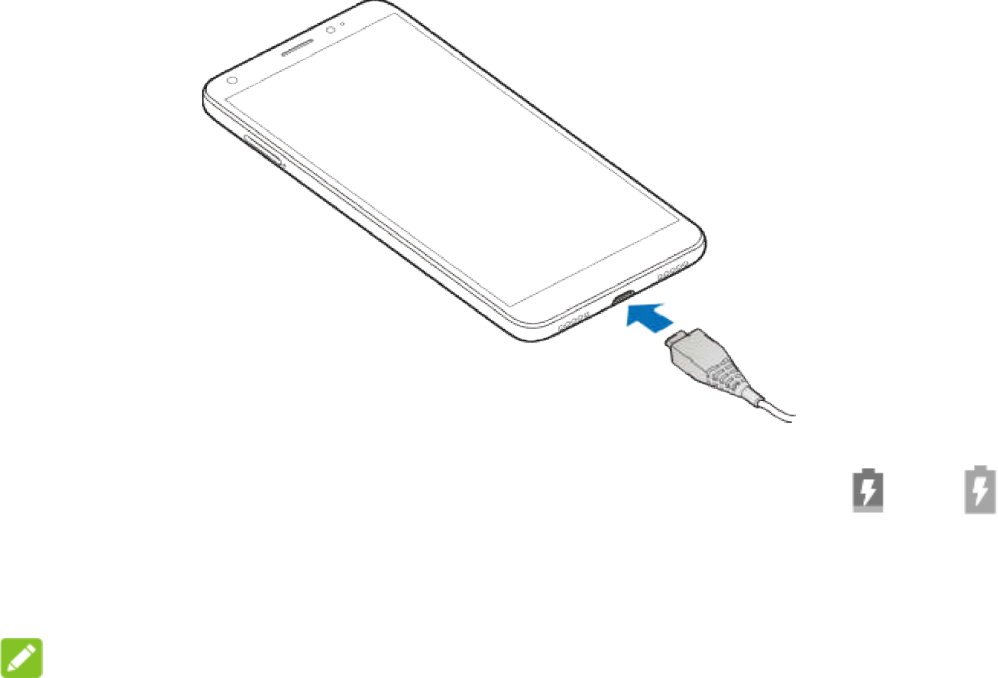
25
2.
Connect the charger to a standard AC power outlet.
phone is on, you’ll see a charging icon, such as
appear on the status bar.
3.
Disconnect the charger when the battery is fully charged.
NOTE:
If the battery is extremely low, you may be unable to power
on the phone even when it is being charged. In this case, try
again after charging the phone for at least 1
0 minutes.
Contact the customer service if you still cannot power on the
phone after prolonged charging.
Powering On/Off
Press and hold the Power key
to turn on your phone.
To switch it off, hold Power key
to open the options menu
and touch Power off.
Connect the charger to a standard AC power outlet.
If the
or ,
Disconnect the charger when the battery is fully charged.
If the battery is extremely low, you may be unable to power
on the phone even when it is being charged. In this case, try
0 minutes.
Contact the customer service if you still cannot power on the
to turn on your phone.
to open the options menu

26
Set Up for the First Time
When you first power on your phone after you purchase it or
reset
it to factory settings, you need to do some settings
before using it.
Touch the language field to select the language you want to
use and then touch LET’S GO
. Then follow the prompts to
set up Wi-
Fi, Google services, add fingerprint and other
options.
WakeUp Your Phone
1. Press the Power key to turn the screen on.
2. Drag towards .
- or -
You can drag towards any direction to access the
application shortcuts.
3. Swipe up on the screen.
NOTES:
You can pull out the starts on the left for a quick view or
action when the screen is turned on.
If you have set a fingerprint, a face verify, an unlock
pattern, a PIN, or a password for your phone, you’ll need
to press your finger against the fingerprintsensor,
look at
the screen, draw the pattern, or enter the PIN/passw
ord
to unlock your screen.
When you first power on your phone after you purchase it or
it to factory settings, you need to do some settings
Touch the language field to select the language you want to
. Then follow the prompts to
Fi, Google services, add fingerprint and other
You can pull out the starts on the left for a quick view or
pattern, a PIN, or a password for your phone, you’ll need
look at
ord
27
Getting Around Your Phone
Touch Control
You can use finger gestures to control your phone. The
controls on your touch-screen change dynamically
depending on the tasks you’re performing.
Touch the buttons, icons, or applications to select items
or to open applications.
Flick the screen to scroll up, down, left or right.
Hold and drag to move particular items across the screen.
Double-tap the screen to zoom in/out an image. Spread
or pinch on with two fingers to zoom in/out a web page.
Home Screen
The home screen is the starting point for your phone’s
applications, functions, and menus. You can customize your
home screen by adding folders, widgets, and more.
Extended Home Screen
Your home screen is extendable, providing more space for
shortcuts, folders, widgets, and more. Simply swipe left or
right on the screen to see the extended panels.
Choose Your Wallpaper
You can set the wallpaper for the home screen and lock
screen.

28
1. Touch the Home key > > >
Display > Advanced
Wallpaper.
2. Slide left or right on the wallpaper panel to select
a built
static wallpaper, or touchMy photos
to select a picture
3. Touch HOME or LOCK.
4. Touch .
NOTE:
Other way to set the home screen wallpaper and the
lock
screen wallpaper:
Touch and hold an empty area of the home screen and
select WALLPAPERS. Then select a built-in image or
touch
My photos to select an image from your gallery
to set the
picture as the wallpaper.
Remove Items from Your Home Screen
1. Touch and hold the item you want to delete.
2. Drag it to / to delete it.
3. If the item is an application, touch OK to uninstall it.
NOTE:
Some preinstalled apps cannot be uninstalled.
Display > Advanced
>
a built
-in
to select a picture
.
lock
touch
to set the
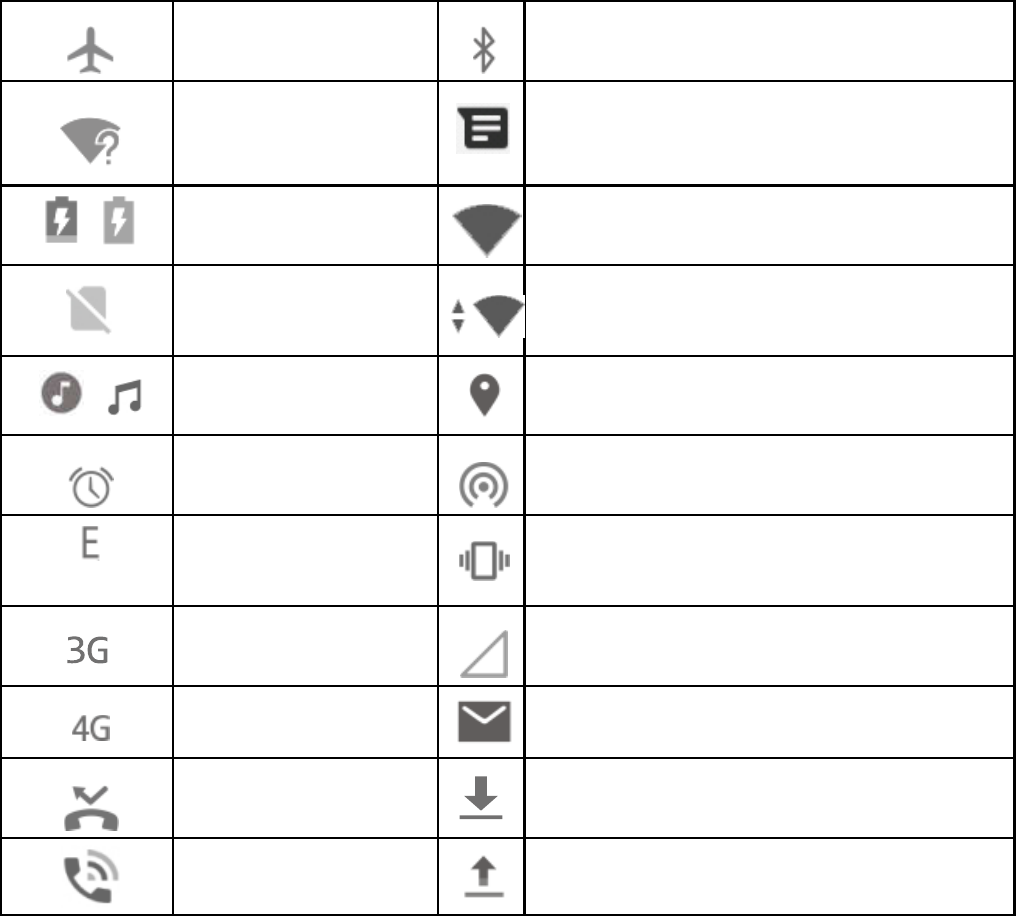
29
Status and Notification Icons
Your phone will tell you exactly what’s going on by showing
you simple icons. Here’s what they mean.
Airplane mode
Bluetooth icon
New Wi-Fi
network detected
New message
/
Battery charging
Connected to a Wi-Fi
®
network
No nano-SIM
card installed Wi-Fi in use
/
Song playing
GPS on
Alarm set
Portable Wi-
Fi hotspot is on
EDGE/2G
connected
Vibration on
3G connected
No signal
4G connected
New email
Missed call
Downloading data
Call in progress
Sending data
Your phone will tell you exactly what’s going on by showing
network
Fi hotspot is on

30
/
Battery low /
Battery full
USB tethering on
Mobile data in
use
Open/Close the Notification Panel
Notifications report the
arrival of new messages, calendar
events, and alarms, as well as ongoing events, such as when
you've configured your phone as a Wi-
Fi hotspot. You can
open the notification panel to view the details of notifications.
To open the notification panel, swipe y
our finger down
from the top of the screen.
To close the notification panel, swipe your finger up on
the screen or touch the Back key.
Using Two Apps in Split-Screen Mode
You can work with two apps at the same time in split-
screen
mode.
NOTE: Not all apps support split-screen mode.
Method one:
1. Touch the Recent appskey
to view your recently used
apps.
2.
Press and hold the tab of the first app you want to use,
and then drag it to Drag here to use split screen.
arrival of new messages, calendar
events, and alarms, as well as ongoing events, such as when
Fi hotspot. You can
open the notification panel to view the details of notifications.
our finger down
To close the notification panel, swipe your finger up on
screen
to view your recently used
Press and hold the tab of the first app you want to use,

31
3. If the second app you want to use is in the recent apps list,
tap its tab. If not, tap the Home Key > to find and open
the app you need.
Method two:
1. Open the first app you want to use, and then press and
hold the Recent apps key.
2. Find and open the second app you want to use, either by
touching the Recent apps key and touching a tab or by
touching the Home Key > .
To turn off split-screen mode, drag to the top or bottom
of the screen.
Phone Calls
Making Calls
You can place calls from the Phone app, the People app, or
other apps or widgets that display contact information.
Wherever you see a phone number, you can usually touch it
to dial.
Call from the Phone
1. Touch the Home key> > .
2. Enter the phone number with the dialpad. Touch to
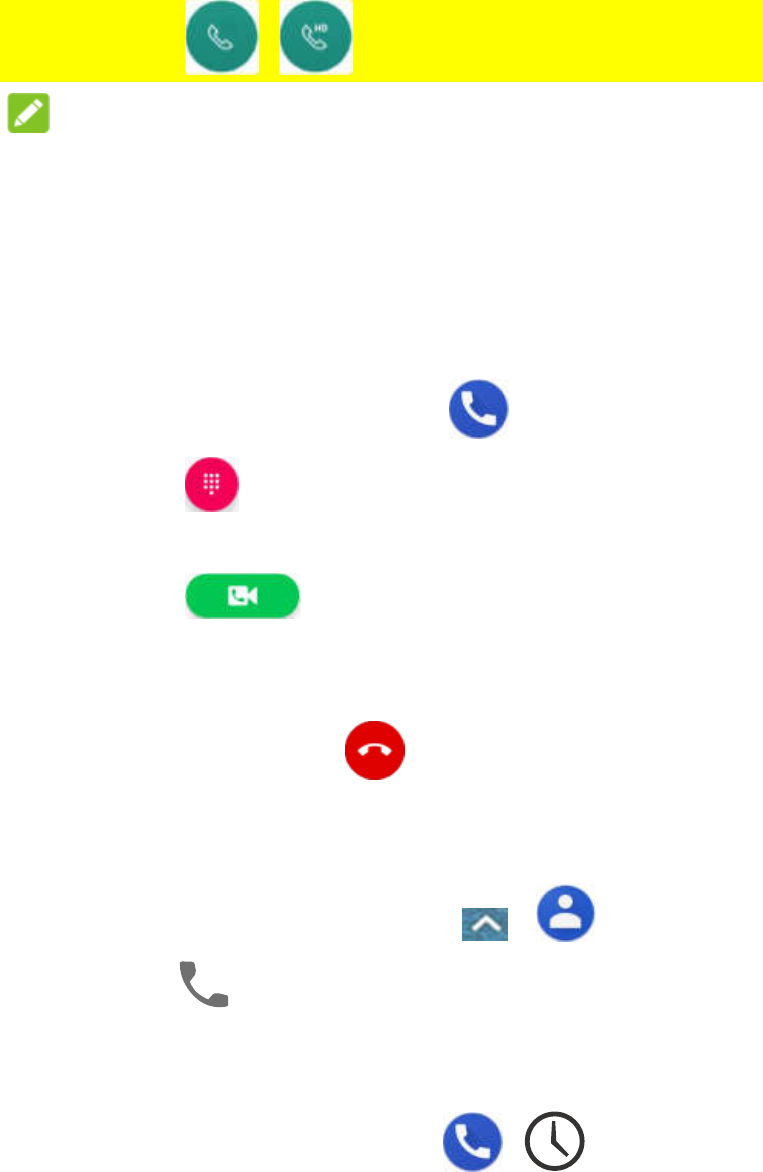
32
delete incorrect digits.
3. Touch / below the keypad to dial.
NOTE:
To make an international call, touch and hold the 0 key to
enter the plus (+) symbol. Next, enter the country code,
followed by the city/area code and then the phone number.
Place a Video Call
1. Touch the Home key >.
2. Touch and enter the phone number or the contact
name with the dialpad.
3. Touch to place the call.
End a Call
During a call, touch on the screen.
Call from Your Contacts
1. Touch the Home key > > .
2. Touch next to a contact to place the call.
Call from Your Call History
1. Touch the Home key > > .

33
2. Touch next to a listing to call back.
Call from a Text Message
If a text message contains a phone number that you want to
call, you can make the call while viewing the text message.
1. Touch the Home key >.
2. Touch the conversation and then find the message that
contains the phone number you need.
3. Touch the number and then touch .
Receiving Calls
Answer a Voice Call
If the phone screen is active, touch .
If the phone screen is locked,slide up to answer the
call.
Answer a Video Call
Touch to answer the video call. You can also touch
to answer the call as a voice call.
- or -
Slide up to answer the video call. You can also slide
to upper-left corner to answer the call as a voice call.
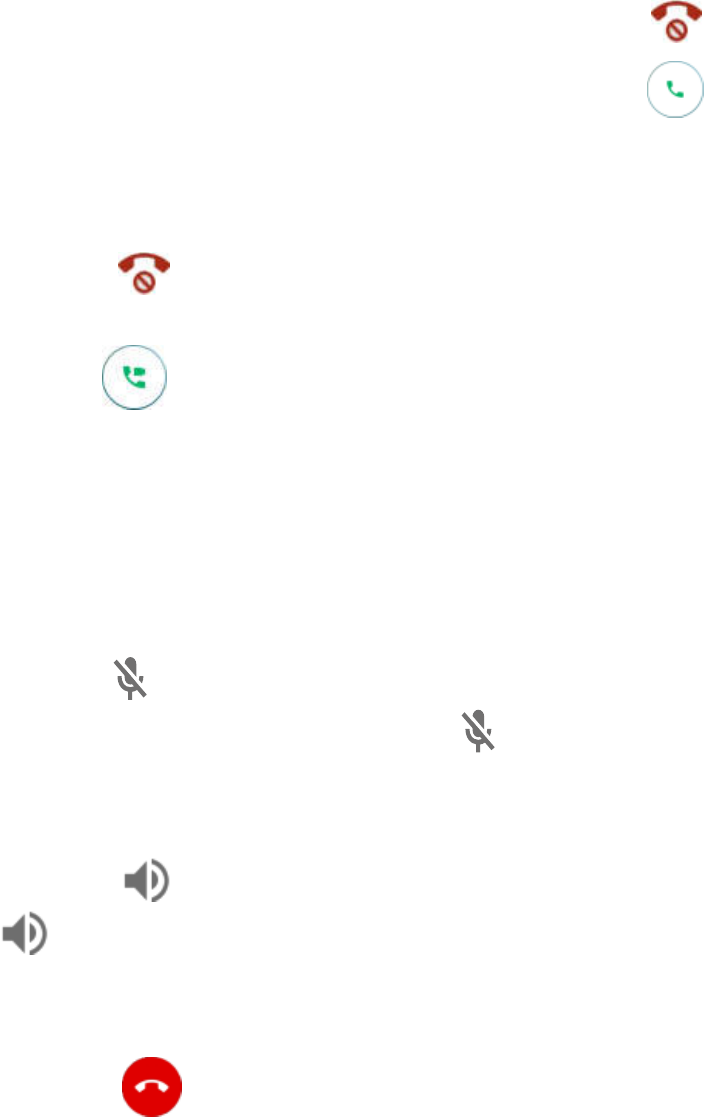
34
Reject a Voice Call
If the phone screen is active, touch .
If the phone screen is locked, slide down
to reject the
call.
Reject a Video Call
Touch to reject the video call.
- or -
Slide down to reject the video call.
Mute a Call
During a call, you can mute your microphone so that the
person you are
speaking to cannot hear you, but you can still
hear them.
Touch to turn your microphone off. To turn your
microphone back on, touch again.
Turn the Speakerphone On/Off
Touch during a call t
o turn the speakerphone on. Touch
again to turn off the speakerphone.
End a Call
Touch to finish a call.
to reject the
During a call, you can mute your microphone so that the
speaking to cannot hear you, but you can still
o turn the speakerphone on. Touch

35
Call settings
Touch the Home key > > >Settings.
Display options
Sort by: Set the order of the contacts.
Name format: Set the format of the
contact names
Sounds and vibration
Phone ringtone:S
elect the ringtone for incoming call
notifications
Also vibrate for calls:E
nable vibration for incoming call
notifications.
Dial pad tones:Play sounds when you touch
the dialpad
keys.
Answer and end calls
Power button ends call:Touch
to enable ending calls by
pressing the Powerkey.
Vibrate when call is answered:Touch
to enable the
phone to vibrate when a call is answered.
Speed dial:
Touch and hold the 1 ~ 9 keys
from the dialer to call the
corresponding
speed dial number.
Call settings
Fixed Dialing Numbers
- Enable FDN:
Input the PIN2 code to enable
the FDN feature.
contact names
.
elect the ringtone for incoming call
nable vibration for incoming call
the dialpad
to enable ending calls by
to enable the
Touch and hold the 1 ~ 9 keys
corresponding
Input the PIN2 code to enable
36
- Change PIN2: Change the PIN2 code for
FDN access.
- FDN list: Manage the FDN list.
Call barring: Forbid certain types of calls.
Call forwarding: Thefeature allows you to forward your
incoming calls to another phone number.
Call waiting: This option allows you to get notified of
incoming calls during a call.
Additional settings: Touch Caller ID to select whether
your number is displayed when someone receives your
outgoing call.
Call blocking: The feature allows you to block calls and
messages from certain numbers.
Voicemail:
Notifications:Touch to set notification sound,
enablevibration for notifications, or configure more
advanced options for notifications.
Advanced Settings
- Service: Select the voicemail service
provider.Yourcarrier is the default.
- Setup: View the voicemail number.
About: View important information about the phone app.

37
Contacts
You can add contacts on your phone and synchronize them
with the contacts in your Google account or other accounts
that support contact syncing.
To see your contacts, touch the Home key > > .
Creating a Contact
1. Touch the Home key > > .
2. Touch to add a new contact.
3. Touch the account field near the top of the screen to
choose where to save the contact. You can save the
contact on the phone, a nano-SIM card, or a web account
you have added on the phone.
4. Enter the contact name, phone numbers, email
addresses, and other information.
5. Touch SAVE.
Searching for a Contact
1. Touch the Home key > > .
2. Touch at the top.
3. Enter the contact name or any information the contact has
to search for it at the top.

38
The contacts matched will be listed.
Messages
You can use Messages to exchange text messages (SMS)
and multimedia messages (MMS).
Opening the Messages Screen
Touch the Home key >.
The Messages screen opens, where you can create a new
message, search for messages, delete messages, or open
an ongoing message thread.
Touch to write a new text or multimedia message.
Touch to search for a message using keywords.
Touch an existing message thread to open the
conversation you’ve had with a certain number.
Sending a Message
1. On the Messages screen, touch at the bottom.
2. Add recipients by one of the following ways.
Enter the phone number or contact name directly in
the "To" field. Touch Send to <number or email
address>or a match from your contacts displayed
below the "To" field to add the number or contact as
the recipient.

39
NOTE:
While entering the recipient, touch and
to
switch between the numeric and the full keyboard.
Touch a contact below the "To" field to whom you
want to send the message.
NOTE:
If you add two or more recipients, the message may be
sent as a group MMS where everyone can reply and see
each other's messages.
3.
Enter the message text. If you want to send a multimedia
message, touch to add attachments.
4. Touch to send the message.
NOTE:
Do not add a message subject or any attachment if you
want to send a text message. Otherwise you may be
charged for a multimedia message.
Changing Message Settings
Touch > Settings
in the Messages screen to change the
messaging settings.
to
switch between the numeric and the full keyboard.
Touch a contact below the "To" field to whom you
If you add two or more recipients, the message may be
sent as a group MMS where everyone can reply and see
Enter the message text. If you want to send a multimedia
Do not add a message subject or any attachment if you
want to send a text message. Otherwise you may be
in the Messages screen to change the

40
Using Your Fingerprint
With the fingerprint sensor on the back of your phone, you
can register up to 5 fingerprints and use them to unlock the
phone, access private space, or open a bound app.
NOTE:
The fingerprint feature is only usable when the screen lock
(Pattern, PIN or Password) is enabled. When the screen
lock is reset to Swipe, all registered fingerprints are erased.
Register a Fingerprint
1. Touch the Home key> > >Security&
Location>Fingerprint>Fingerprint management.
2. Enter the screen lock pattern, PIN, or password you set. If
you haven’t set a screen lock, follow the prompts to set it.
3. Touch REGISTERor Add fingerprint.
4. Follow the prompts to record the center and then the
edges of a finger.
5. Touch OK.
NOTE:
Touch an existing fingerprint record to change its name or
delete it.

41
Set Fingerprint Actions
1. Touch the Home key> > >Security&
Location>Fingerprint.
2. Set the functions as you need:
Take photo: Touch the fingerprint sensor to take a
photo when the Camera app is opened. No fingerprint
verification is needed.
Answer call: Touch the fingerprint sensor to answer
incoming calls. No fingerprint verification is needed.
View notification drawer: Swipe down on fingerprint
sensor for any screen to unfold notification drawer;
swipe up to fold it.
View recent apps: When viewing the home screen,
swipe up on the fingerprint sensor for recent apps.
View pictures: Launch Gallery and then swipe left or
right on fingerprint sensor to view picture.
Management Fingerprints Lock Functions
1. Touch the Home key> > >Security&
Location>Fingerprint > Fingerprint management.
2. Enter your pattern, PIN, or password.
3. Set the functions as you need:
Wake up and unlock your phone: When the screen
lock (Pattern, PIN or Password) is enabled, you can

42
wake up the phone and unlock it with a registered
fingerprint.
Access Private Space: Access privacy of private
space with a registered fingerprint.
Simple touch: Use your registered fingerprint to open
a bound app when the screen is off or locked.
Using Face Detection to Unlock
screen
You can use face detection to unlock screen without entering
the password, or unlock the screen without entering the
specific PIN/password, or draw the pattern.
To create my face for face detection
1. Touch the Home key> > >Security&
Location>Face Verify.
2. Enter the screen lock pattern, PIN, or password you set. If
you haven’t set a screen lock, follow the prompts to set it.
3. Disclaimer for Face Detect appears while you use the
face detection at the first time. Touch CONTINUE. Find a
spot that is neither too bright nor too dim. Touch CREATE
NOW.
4. Keep your face 20 cm to 50 cm away from the screen.
Wait for a moment until the phone has created the face
successfully.

43
NOTES:
You can touch Attemptation of verification in the
Face
Detect screen
, and put your face in the screen to confirm
whether the created face works or not.
Touch Create again in the Face Detect screen to
recreating your face and erasing the former one at the
mean time.
To unlock screen via face detection
1. When the screen locked, press the Power key
to turn the
screen on.
2. Drag towards
3.
Find a spot that is neither too bright nor too dim and keep
your face 20 cm to 50 cm away from the screen to unlock
the screen via face detection. If it doesn’
t work, you can
touch to unlock screen via face detection.
Connecting to Networks and
Devices
Setting Access Point Names
To connect to the Internet you can use the default Access
Point Names (APN). And if you want to add a new APN,
please contact the service provider to
get the necessary
Face
, and put your face in the screen to confirm
recreating your face and erasing the former one at the
to turn the
Find a spot that is neither too bright nor too dim and keep
your face 20 cm to 50 cm away from the screen to unlock
t work, you can
To connect to the Internet you can use the default Access
Point Names (APN). And if you want to add a new APN,
get the necessary

44
information.
1. Touch the Home key> > >Network&
Internet >
Mobile network.
2. Touch Access Point Names > .
3. Touch
each item to enter the information you get from
your service provider.
4. Touch >Save to complete.
NOTE:
To set the APN to default settings, touch >Reset to
default.
Turning Wi-Fi On and Connect to a Wi
Network
1. Touch the Home key> > >Network
& Internet >
Wi-Fi.
2. Slide theswitch to On positionto turn on Wi-Fi.
3. Touch a network name to connect to it.
4.
If the network is secured, enter the password and touch
CONNECT.
NOTE:
Your phone automatically connects to previously used Wi
networks when they are in range.
Internet >
each item to enter the information you get from
-
Fi
& Internet >
If the network is secured, enter the password and touch
Your phone automatically connects to previously used Wi
-Fi

45
Bluetooth
Bluetooth® is a short-range wireless communication
technology. Phones or other devices with Bluetooth
capabilities can exchange information wirelessly within a
distance of about 10 meters (32.8 feet). The Bluetooth
devices must be paired before the communication is
performed.
1. Touch the Home key > > >Connected
devices >Bluetooth.
2. Slide theswitch to On positionto turn on Bluetooth.
When Bluetooth is on, the icon appears in the status
bar.
Tethering & portable hotspot
You can share your phone’s data capabilities through
tethering or by activating the mobile hotspot feature to create
a portable Wi-Fi hotspot.
Share Your Mobile Data Connection via USB
You cannot transfer files between your phone and your
computer via USB while the phone is USB tethered.
1. Connect your phone to your computer with a USB cable.
2. Touch the Home key > > > Network &
Internet >Hotspot & tethering.

46
3. Switch on USB tethering
. A new network connection will
be created on your computer.
NOTE:
To stop sharing your data connection, switch off USB
tethering or disconnect the USB cable.
Share Your Mobile Data Connection via Bluetooth
1. Pair your phone with your computer via Bluetooth.
2.
Configure your computer to obtain its network connection
via Bluetooth. For more information, please see your
computer's documents.
3. Touch the Home key > > > Network &
Internet >Hotspot & tethering.
4. Switch on Bluetooth tethering. Your computer
is now
sharing your phone's data connection.
NOTE:
To stop sharing your data connection, switch off
Bluetooth
tethering.
Share Your Mobile Data Connection as a Wi-
Fi Hotspot
When the portable Wi-
Fi hotspot feature is enabled, you
cannot use your phone’s Wi-Fi capability to access the
Internet. You still remain connected to the Internet via your
mobile data network.
1. Touch the Home key > > >
Network & Internet
. A new network connection will
Configure your computer to obtain its network connection
via Bluetooth. For more information, please see your
is now
Bluetooth
Fi Hotspot
Fi hotspot feature is enabled, you
Internet. You still remain connected to the Internet via your
Network & Internet
>
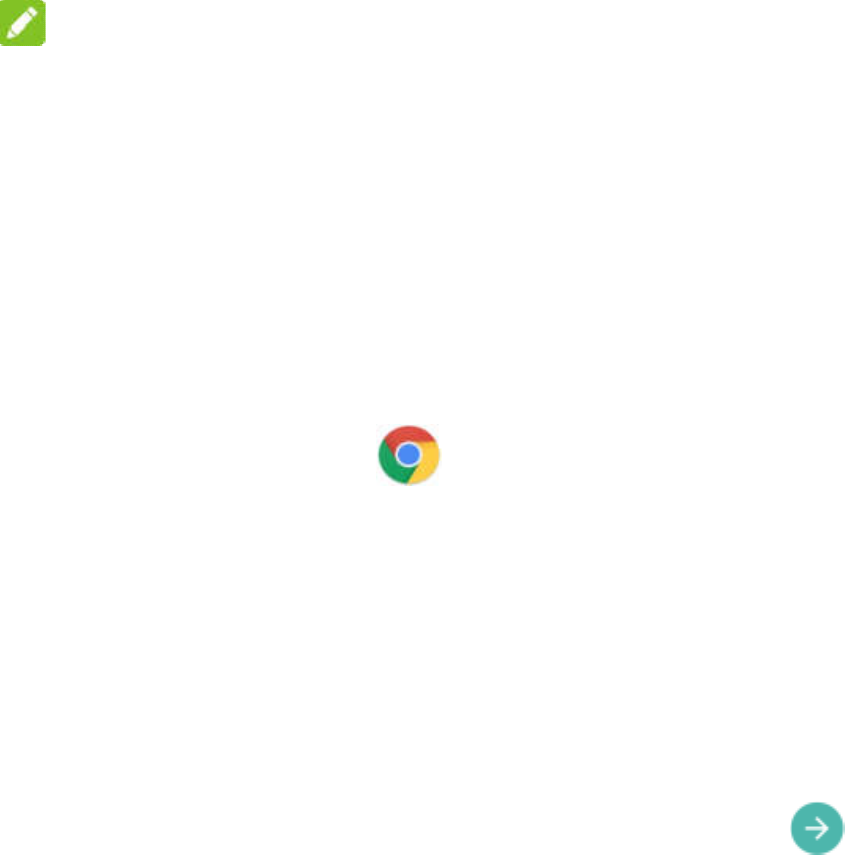
47
Wi-Fi Hotspot.
2. Switch on Wi-Fi Hotspot.
After a moment, the phone starts broadcasting its
Wi
network name (SSID).
3. On another device, locate your phone via Wi-
Fi and
connect with it to start using the phone’s mobile data.
NOTE:
To stop sharing your data connection, switch off
Hotspot.
Chrome
Use Chrome to view web pages and search for
information.
Opening the Browser
Touch the Home key >
to launch the web browser.
You can also open the browser by touching a web link
example, in an email or a text message.
1. Open the Chrome app.
2. Touch the address box.
3. Enter the address (URL) of a webpage or
enter terms you
want to search for.
4. Touch a URL or search suggestion or touch
on the
keyboard to open the web page or search results.
Wi
-Fi
Fi and
connect with it to start using the phone’s mobile data.
Wi-Fi
information.
to launch the web browser.
You can also open the browser by touching a web link
- for
enter terms you
on the

48
Using Multiple Browser Tabs
You can open several web pages at the same tim
e (one page
in each tab) and switch between them freely.
To open a new browser tab:
Touch > New tab. A new browser tab opens.
To switch between tabs:
1.
Touch . Titles of opened tabs appear as a list.
2.
Touch the title you want to open.
NOTE:
Swipe a title horizontally or touch to close the tab.
Downloading Files
1.
Touch and hold an image or a link to a file or to another
web page.
2. In the menu that opens, touch Download image or
Download link.
The downloaded files are saved to your phone. You
can view
or open them in the Downloads
app. You can also view
download links in > Donwnloads.
Changing Browser Settings
You can configure a number of settings to customize the way
you browse the web, including several that you can use to
control your privacy.
e (one page
Touch and hold an image or a link to a file or to another
can view
app. You can also view
You can configure a number of settings to customize the way
you browse the web, including several that you can use to

49
To open the browser settings screen, touch
> Settings
Using Multimedia Apps
Taking Pictures withYour Camera
1.
Touchthe Home key>.
2.
Aim the camera at the subject and make any necessary
adjustment.
PHOTO (automatic
camera) mode is used by
default
.
NOTE:
You can spread or pinch on the screen to zoom in or out
before taking pictures.
3.
Touch the area where you want the camera to focus, or
leave the camera to autofocus on the center of the image.
NOTE:
In Au
to camera mode, when you touch the screen to
focus, the exposure bar appears beside the focus point.
You can drag
up or down to adjust the exposure
4.
Lightly touch . The Volume
key can also be used to
take a photo.
Recording VideoswithYour C
amcorder
1. Touchthe Home key >.
> Settings
.
Aim the camera at the subject and make any necessary
camera) mode is used by
You can spread or pinch on the screen to zoom in or out
Touch the area where you want the camera to focus, or
leave the camera to autofocus on the center of the image.
to camera mode, when you touch the screen to
focus, the exposure bar appears beside the focus point.
up or down to adjust the exposure
key can also be used to
amcorder
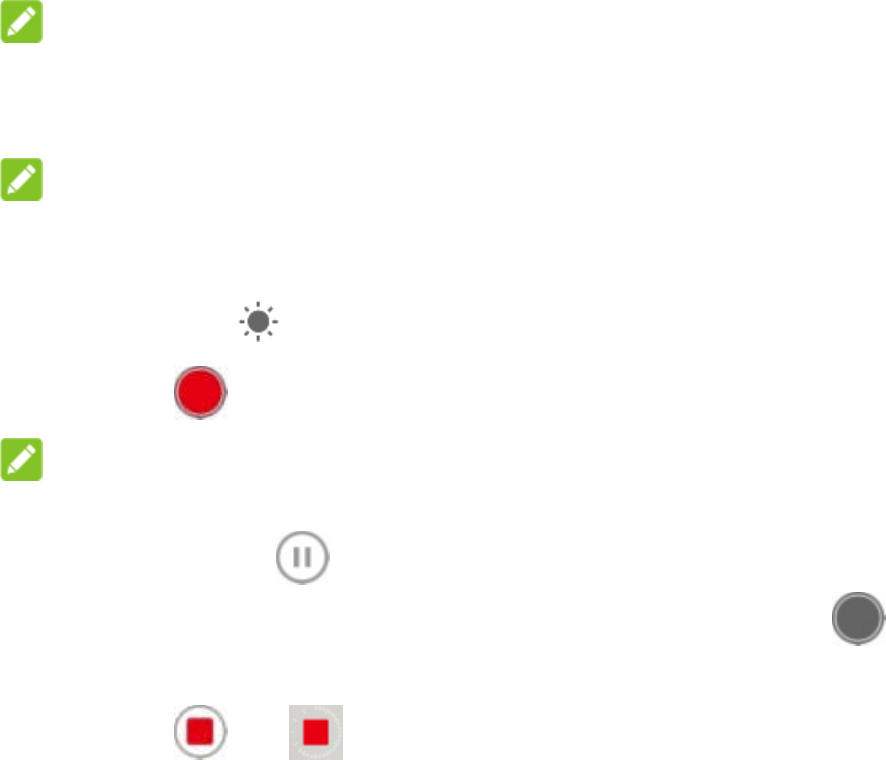
50
2. Touch VIDEO if you want to capture a normal-
speed
video. To capture slow motion or time lapse video,
touch … > SLOW MOTION or TIMELAPSE.
3. Aim the camera at the subject.
You can touch any area on
the screen that you want the camcorder to focus on
before and during recording.
NOTE:
You can spread or pinch on the screen to zoom in or out
before and during recording.
NOTE:
When you touch the screen to focus during normal-s
peed
recording, the exposure bar appears beside the focus point.
You can drag up or down to adjust the exposure.
4. Touch to start recording.
NOTE:
While the normal-speed recording or slow motion video
is in
progress, touch
to pause the recording. When you
record a normal-speed or time-lapse video, touch
to
save the frame as a separate photo.
5. Touch or to stop recording.
Listening to Your FM Radio
With the FM Radio, you can search for radio channels, listen
to them, and c
ollect them to your phone. Note that the quality
speed
You can touch any area on
You can spread or pinch on the screen to zoom in or out
peed
recording, the exposure bar appears beside the focus point.
is in
to pause the recording. When you
to
With the FM Radio, you can search for radio channels, listen
ollect them to your phone. Note that the quality

51
of the radio broadcast depends on the coverage of the radio
station in your area. The wired headset works as an antenna,
so always connect the headset when using the radio.
1. Plug your headset into your phone.
2. Touch the Home key >>.
Playing Your Music
Music supports a wide variety of audio formats, so it can play
music you purchase from online stores, music you copy from
your CD collection, and so on.
1. Touch the Home key>>> All songs to see the
music library.
2. Touch a song in any list.
Opening Your Gallery
Touch the Home key > > to view albums of your
pictures and videos.
Making VoiceMemos
Recorder enables you to record voice memos and listen to
them whenever you like.
1. Touch the Home key> > .
2. Touch to start recording. During recording, you can

52
do the following:
Touch / to pause or continue the recording.
Touch to add time tags to the recording.
3. Touch DONE to stop recording.
4. Edit the file name and touch SAVE to save the recording.
If you don’t want to save the memo after recording it, touch
DELETE> DELETE to delete it.
Using Your Google Applications
Signing in to your Google Account lets you synchronize
Gmail, Calendar, and Contacts between your phone and the
web. And if you don’t have an account, you can easily create
one.
Gmail
Gmail is a web-based email service that’s configured when
you sign in to your Google account. Depending on your
synchronization settings, the Gmail on your phone can be
automatically synchronized with your Gmail account on the
web.
To open Gmail by touching the Home key > > .

53
Google Play™ Store
Touch the Home key >. You can buy or rent music,
books, movies, apps, and download them to your phone.
NOTE:
The content you can access in Google Play Store depends
on your region and your service provider.
Other Applications
Clock
Touch the Home key > > . The Clock app allows you
to check local time in places around the world, set alarms,
and use timers.
FileManager
Quickly access all of your images, videos, audio clips, and
other types of files on your phone storage.
Touch the Home key > > . You can touch a file
category to find the file you need, or touchLOCAL, and
thenPhone, SD Card, or External devices to browse folders
and files on the phone storage, the microSDXC card, or the
connected OTG device.

54
Downloads
The Downloads app keeps a record of the files you have
downloaded using apps such as Chrome or Email.
Touch the Home key > > .
Settings
The Settings app contains most of the tools for customizing
and configuring your phone.
At the top of the Settings screen, you can see setting
suggestions. Tap to check or customize the recommended
settings.
Network & Internet
Wi-Fi
Touchthe Home key> > >Network & Internet >Wi-Fi.
You can turn Wi-Fi on or off and configure your Wi-Fi
connections.
Mobile Network
Touch the Home key> > >Network & Internet>Mobile
network to select network type, control data roaming, or set
access point names.

55
Data Usage
Touchthe Home key> > >Network & Internet >Data
usage to manage mobile data use.
Touch the switch next toMobile datato turn on or off mobile
data.
Touch Mobile data usage to check how much data has been
used during the time cycle you set, set mobile data limit and
warning, see what apps have been using mobile data, or
restrict background data for individual apps.
NOTE:
The data usage is measured by your phone, and your
carrier’s data usage accounting may differ.
Hotspot & Tethering
Touchthe Home key> > >Network & Internet >
Hotspot & tetheringto share your phone’s mobile data
connection with PCs or other devices via USB and Bluetooth.
VPN
Touchthe Home key> > >Network & Internet > VPN to
set up and connect to virtual private networks.

56
Wi-Fi Hotspot
Touchthe Home key> > >Network & Internet > Wi-Fi
Hotspot to share your phone’s mobile data connection with
PCs or other devices via Wi-Fi.
Airplane Mode
Touchthe Home key> > >Network & Internet,and then
slide the switch beside Airplane mode to turn airplane mode
on or off.All the phone’s radios that transmit voice or data are
turned off when airplane mode is on.
Call Settings
Touch the Home key > > >Network & Internet> Call
settings to configure call options.
Connected Devices
Bluetooth
Touchthe Home key> > >Connected
devices >Bluetooth. You can turn Bluetooth on or off and
configure your Bluetooth connections.
Cast
Touchthe Home key> > >Connected devices > Cast.
You canconnect with TVs, projectors or other devices that
support wireless display and project your phone’s content

57
wirelessly to that device. For detailed introduction, please refer to
the device manual.
USB
Touchthe Home key> > >Connected devices > USB
to select your USB connection type between your phone and
PC.
Printing
Touch the Home key> > >Connected
devices >Printing to manage Google Cloud Print service or
other printer plug-ins installed from the Google Play Store or
your printer manufacturer.
Apps & Notifications
Touch the Home key> > > Apps & notifications tosee
apps installed on your phone and manage them,or control
the display of notifications.
Featured
Touch the Home key> > > Featured to exchange the
location of the Recentapps key and the Back key, turn on or
off Mi-Pop function, or control the phone with special finger
gestures or moving the phone in different ways.

58
Power Manager
Touchthe Home key> > > Power manager to view the
battery level, check what has been using the battery, and
enable different battery saving modes.
Display
Touchthe Home key> > > Display to configure the
display options.
Sound
Touchthe Home key> > > Sound. You can adjust
different types of volume, toggle sound, vibration and mute,
set up ringtone and notification sound, or select touch
sounds.
Storage
Touchthe Home key> > >Storage to view the memory
information of the internal phone storage and the microSDXC
card.
You can get a detailed breakdown of space usage by type.
Touch a data type to see more information or delete the files
you do not need.

59
Security& Location
Touchthe Home key> > > Security& Locationto
configure options that help keep your phone and data safe,
or manage location services, which help your phone and
apps determine your location.
Accounts
Touchthe Home key> > > Accounts to manage your
web accounts and synchronization. Touch Add account to
sign in to or create accounts on your phone.
Touch an account type to see that type of accounts you have
added and adjust the accounts settings.
Accessibility
Touchthe Home key> > > Accessibility to configure
accessibility plug-ins and services on your phone, such as
using Color inversion or High contrast text for users with
sight problems.
Google
Touchthe Home key> > >Google to easily manage
settings for Google apps and features. You can set the
options for Google account and services.

60
System
Touchthe Home key> > >System to configure options
related to system language, input methods, view important
phone information and legal information, set date and time,
manage data backup options, and reset the network setting
or the phone to factory status.